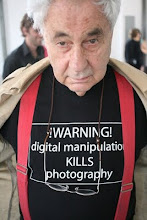German photographer Michael Schmidt, like Dutch designer Christien Meindertsma who was profiled in the previous post, spends several years on a single project. Schmidt is best known for Waffenruhe (Ceasefire), a study of Berlin immediately before the fall of the Wall, which is widely considered one of the greatest contemporary photobooks.
Schmidt's latest obsession is the mechanized, industrialized food system of contemporary Western culture. The project has resulted in a book, Lebensmittel (Food), and is currently being exhibited in Europe.
Using his trademark style combining social documentary and urban topographics, he explores the fascinating topic of how we feed ourselves, from the farm to the table (or the fast-food restaurant).
Here is what Artforum has to say about the associated exhibition:
With his current exhibition, “Lebensmittel” (Food), which consists of 177 photographs, Berlin-based photographer Michael Schmidt debuts the results of his research into agribusiness, which between 2006 and 2010 took him to many different locations throughout Europe. Schmidt sought out places where edibles are produced, packaged, distributed, and sold. Yet the specific locations are never revealed, neither in the exhibition nor in the accompanying catalogue. Thus the mostly uninhabited cultivated fields and plantations, the motifs of fish, pig, and cattle breeding, of large-scale bakeries as well as supermarkets, appear to be anonymous and exchangeable: everywhere and nowhere.
Michael Schmidt // Waffenruhe from haveanicebook on Vimeo.
Schmidt’s interest in a nonspecifity of place should come as no surprise. He is known not for single images but for vastly conceived series, as in the case of “EIN-HEIT” (Unity), 1991–94; “Waffenruhe” (Ceasefire), 1985–87; and “Irgendwo” (Somewhere), 2001–2004. In the present show, which can be seen in Innsbruck this summer and in Berlin next spring, it is precisely a multitude of images that Schmidt pursues. Within the series, an image forms of the maximally rationalized production of edible goods.
There are nonetheless two narrative lines to be read: On the one hand, the observer is confronted with technical equipment which one only recognizes after a closer look as a fish farm or mussel bank. One sees sheer endlessness: one part of a stripped field, fenced-in production facilities that reveal nothing as to what will be processed there. Other shots reveal the subject under investigation at close range: broken eggs behind glass, shrink-wrapped and labeled beef, swollen udders with milk stools set at the ready, greased griddles from which tumble french fries, a great green apple in front of Styrofoam. In this time of food scandals, one might suspect these photographs to be a means of agitation. But this is clearly not Schmidt’s intention. “Lebensmittel,” in all its clarity, comes across instead as the cool image-record of a complex system on the brink of collapse.
The following video, even if you don't speak German, provides a wider look at the images and, more significantly, illustrates the comparative power of the exhibition relative to the presentation of the same images in book form.







































